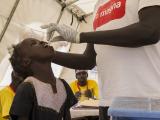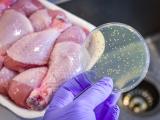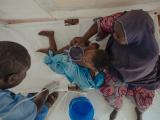Nov 24, 2004 (CIDRAP News) The US Department of Agriculture (USDA) ended 6 days of suspense for the beef industry by announcing late yesterday that a cow suspected of having bovine spongiform encephalopathy (BSE) didn't have the disease after all.
"The USDA National Veterinary Services Laboratories (NVSL) in Ames, Iowa, has determined that the inconclusive screening test sample reported on Nov 18 has tested negative for BSE upon confirmatory testing," said John Clifford, deputy administrator of the Animal and Plant Health Inspection Service (APHIS).
Two screening tests on the cow had been inconclusive, prompting the USDA to announce the findings Nov 18 and send samples to the NVSL for confirmatory tests. This was the third cow for which screening tests were inconclusive since the USDA expanded its BSE surveillance program June 1.
Clifford said that to be safe, the USDA ran two immunohistochemistry (IHC) tests, known as the "gold standard" test for BSE, on the cow. The first negative result came Nov 22. "Because the Nov 18 screening test results were reactive in both the first and second screens, NVSL scientists made the recommendation to run the IHC test a second time," he said. "On Nov 23 they reported the second IHC test was negative. Negative results from both IHC tests make us confident that the animal in question is indeed negative for BSE."
The USDA did not reveal where the cow came from or any other details about it. The agency said earlier that the carcass was kept out of the food and animal feed production chains.
The agency expanded its BSE surveillance this year in response to the discovery of the nation's first BSE case in a cow in Washington state last December. Beef prices dropped in late June when the USDA announced the first two suspected BSE cases on the basis of single screening tests, but further tests ruled out both cases a few days later. In August the agency announced that henceforward it would announce a suspected case only after two inconclusive tests on the same animal.
When the suspected case was announced last week, beef prices weathered the storm better than they did the last time, according to an Associated Press report. Beef futures prices on the Chicago Mercantile Exchange dropped from 87.3 cents to 84.2 cents a pound, but they recovered to 87.25 cents as of yesterday, the report said.
The National Cattlemen's Beef Association (NCBA) said the latest case shows that measures to protect the public from exposure to BSE are working. "This animal never entered the human food supply, nor did it enter the animal feed chain, proving the systems in place are working to protect public and animal health," said NCBA Vice President Jan Lyons, a Manhattan, Kan., cattle producer, in a prepared statement.
Lyons noted that the USDA has said that more BSE cases may be found, but added, "Beef is safe from BSE because anything that could potentially carry BSE is prohibited from entering the food supply."
Carol Tucker Foreman of the Consumer Federation of America, a leading critic of government food safety policies, said yesterday's announcement is "good news and a relief for everyone," but added that the system for protecting the public from BSE still has a number of gaps.
The USDA and Food and Drug Administration have banned the use of high-risk cattle parts such as the brain and spinal cord, called specified risk materials (SRMs), in human food. But Foreman said the ban still permits the use of some potentially hazardous material, such as the sheath (dura) that covers the spinal cord, and slaughter plants can use the same blades for removing SRMs and for processing meat without sterilizing them in between. She also charged that the rules are not well enforced.
See also:


















